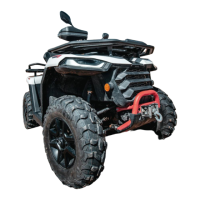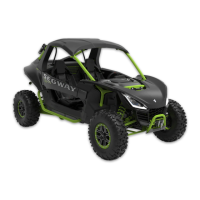Why is my Segway Offroad Vehicle engine pinging or knocking?
- WWilliam ClarkAug 14, 2025
Engine pinging or knocking can occur if you are using poor quality or low octane fuel. Replace the fuel with the recommended type.

Why is my Segway Offroad Vehicle engine pinging or knocking?
Engine pinging or knocking can occur if you are using poor quality or low octane fuel. Replace the fuel with the recommended type.
What to do if my Segway SGW570F-A2 Offroad Vehicle has low battery voltage?
If your Segway Offroad Vehicle has low battery voltage, recharge the battery to 12.5 VDC.
What to do if my Segway Offroad Vehicle circuit breaker tripped?
If the circuit breaker in your Segway Offroad Vehicle has tripped, reset it.
What to do if my Segway SGW570F-A2 is stuck in mud or snow?
If your Segway Offroad Vehicle is stuck in mud or snow, shift the transmission to low range. Then, carefully use fast, aggressive throttle application to engage the clutch. Be careful, excessive throttle may cause loss of control and vehicle overturn.
How to fix poor engine performance on a Segway SGW570F-A2 Offroad Vehicle?
Check for fouled plugs or foreign material in the gas tank, fuel lines, or throttle.
What to do if my Segway SGW570F-A2 Offroad Vehicle has loose battery connections?
If you find that your Segway Offroad Vehicle has loose battery connections, check all connections and tighten them.
What to do if my Segway SGW570F-A2 has loose solenoid connections?
If you discover that your Segway Offroad Vehicle has loose solenoid connections, check all connections and tighten them.
What to do if my Segway SGW570F-A2 is climbing over large objects from a stopped position?
When climbing over large objects from a stopped position with your Segway Offroad Vehicle, shift the transmission to low range. Carefully use fast, brief, aggressive throttle application to engage the clutch, but be aware that excessive throttle may cause loss of control and vehicle overturn.
What to do if my Segway Offroad Vehicle has belt slippage from water or snow ingestion into the CVT system?
If your Segway Offroad Vehicle experiences belt slippage due to water or snow in the CVT system, remove the CVT cover and drain the water from CVT.
| Brand | Segway |
|---|---|
| Model | SGW570F-A2 |
| Category | Offroad Vehicle |
| Language | English |
Details about warning labels on the vehicle for safety. Includes descriptions of various warning symbols.
Critical safety instructions and precautions for operating the vehicle safely.
General safety guidelines and recommendations for safe riding practices.
Steps and requirements for activating the new vehicle via the mobile app.
Localization of key vehicle parts and controls with numbered diagrams.
Explanation of various switches located on the vehicle's handlebars for different functions.
Describes the ignition lock positions (Steering Lock, Power On, Power Off) and their functions.
Details the engine start (green) and stop (red) buttons and vehicle launch/stop procedures.
Explains the headlight switch positions for high beam, low beam, off, and position light modes.
Explains the function of the accelerator control for engine speed and safety warnings.
Overview of the instrument panel and its components.
Explains the various indicator and warning lights on the instrument panel and their meanings.
Guidance on how to adjust the handlebars for optimal rider comfort and control.
General guidelines and etiquette for riding the ATV on various terrains.
Detailed steps for safely starting the vehicle's engine and preparing for operation.
Techniques for turning the vehicle safely, including body positioning and speed control.
Techniques and precautions for safe ascent on hills, including body weight shifts.
Essential pre-ride checks to ensure the vehicle is in safe operating condition.
Information on vehicle load limits, carrying capacity, and safe loading guidelines.
Detailed instructions and safety precautions for operating the vehicle's winch.
A comprehensive table outlining periodic maintenance intervals and tasks.
Guidelines for engine oil maintenance, including recommendations and warnings.
Information related to tire maintenance, including pressure and tread depth.
Guidelines for checking and maintaining correct tire pressure for optimal performance and safety.
How to adjust the shock absorber settings for different riding conditions.
Information on the air filter element, its maintenance, cleaning, or replacement.
Maintenance and replacement procedures for vehicle lamps, including headlights and taillights.
Information on the recommended spark plug type, clearance, and inspection.
Information on the 12V battery, its handling, charging, and installation/disassembly.
Safety precautions and procedures for charging the 12V vehicle battery.
Information about fuses, their purpose, and precautions for replacement.
Guidelines for maintaining the vehicle's exterior appearance, including cleaning and storage.
Detailed specifications and dimensions of the vehicle models.
Information on locating and recording the vehicle's frame and engine identification numbers.
Troubleshooting steps for issues related to the drive belt and its cover.
Common causes and solutions when the engine fails to crank or start.
Troubleshooting steps for issues where the engine stops unexpectedly or loses power.
Troubleshooting steps for engine performance issues like rough running, stalling, or misfiring.
Explanation of the sources of exhaust emissions and their components.
Overview of the exhaust emission control system and its components.
Details on the crankcase emission control system and its function.
Details of the limited warranty coverage for new Segway vehicles.
List of conditions and damages not covered under the vehicle's warranty.
Information on the limitations of warranty coverage and available remedies.
A log to record periodic maintenance performed on the vehicle.











